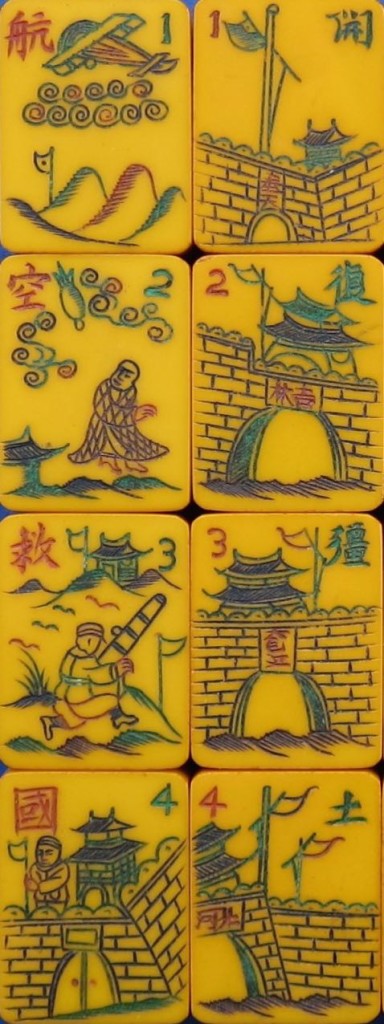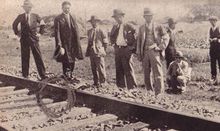We are featuring another war set on this website, representing the war between the Japanese and the Chinese during the 1930s. This particular set has 16 Flowers, and thus a lot of information, all of which deserves study. I am dividing this set into two posts, each looking at eight different tiles.
For many years, resource poor Japan had their eyes on China, their neighbor to the West. This desire for China's resources, among other reasons having to do with a united Asia under Japanese rule, led to the Second Sino-Japanese War which effectively started in 1931. These mahjong tiles seem to deal with events from those years. The carvers possibly were hoping to rally people to combat the more major take-over of China which began in 1937. Remember, Mahjong is a game, something that was played to get away from the troubles of the day, and yet for the Chinese, there was no escape from war time troubles. Given the presence of Arabic numbers on these tiles, this set was meant for export.
Ray Heaton and Michael Stanwick have translated the tiles.
The left column of tiles contains the term: Aviation to Save the Nation, a term we have seen before, coined by Dr Sun Yat-Sen, who had great hopes that the Chinese would be able to develop a strong aviation presence. According to Peter Harmsen, in his very well-researched book Shanghai 1937 Stalingrad on the Yangtze, during the 1930s, there were actually two flight schools. One was overseen by the Italians, who were sent to China by Mussolini. Il Duce wanted to ensure that Italy would have a good part of China's aviation business. That school was very poorly run, so much so the planes that had crashed were counted as being ready for flight! And equally sad, the training program graduated everyone, even people who were totally unfit pilots. Luckily another flight school, out of Hangzhou, was doing a better job. In other words, the Chinese were no match for the skilled and very well prepared and outfitted Japanese.
Of course if you are familiar with the E.A. R. Fowles set, you will have already seen a tile similar to the 2nd tile in the first column. We see hopes that the Chinese will be able to become strong enough in the air to be able to drop bombs on their Japanese enemies.
The 2nd column is very interesting: the Characters at the tops of the tiles translate to move troops to recover territory, something that we have seen on other sets of tiles. A few of the gates may represent towns, such as Tile #2, Ji Lin, which is in Manchuria. Tile #3 translates as Yan Jiang, or Flood Yangtze River. 1931 is the year the Japanese invaded and took over Manchuria, "prompted by" the Mukden incident (and you can read about that in the Wikipedia article linked below). It was right after the terrible flooding of the Yangtze River in July and August, which was responsible for the deaths of between 145,000 and 4,000,000 people. I don't know if there is cause and effect here, but maybe the government of China was coping with this flood, and the Japanese took advantage. Or perhaps the wall merely marks the timing of the take over of Manchuria.
The railroad sabotage on the Japanese line which ran through China, which was blamed on the Chinese although it had been carried out by the Japanese, was termed the Mukden Incident. Please pay attention to the amount of "destruction" done to the tracks
From Wikipedia:
Incident
Colonel Seishirō Itagaki, Lieutenant Colonel Kanji Ishiwara, Colonel Kenji Doihara, and Major Takayoshi Tanaka had laid complete plans for the incident by May 31, 1931.[8]
The plan was executed when 1st Lieutenant Suemori Komoto of the Independent Garrison Unit (独立守備隊) of the 29th Infantry Regiment, which guarded the South Manchuria Railway, placed explosives near the tracks, but far enough away to do no real damage. At around 10:20 PM (22:20), September 18, the explosives were detonated. However, the explosion was minor and only a 1.5-meter section on one side of the rail was damaged. In fact, a train from Changchun passed by the site on this damaged track without difficulty and arrived at Shenyang at 10:30 PM (22:30).[9]
This incident ultimately led to the Japanese take-over of Manchuria, a loss that was crushing to many Chinese people, who felt they had lost part of their country. Perhaps this was the "lost territory" the mahjong carvers hoped to inspire the Chinese people to recapture.
Mao Zedong was well aware of the power of propaganda. He was the head of the Propaganda Department. Zhang states:
The CCP leader Mao Zedong commented in 1937:
"Our party should strictly obey the following guidelines: [we will] spend one cent [of effort on] fighting against the Japanese [directly on the battlefield]; two cents on marginal expenses; seven cents on recruiting [new Party members]; ten cents in propaganda."[77]
To read more about the precursors of the war, you might want to look at Wikipedia:
http://en.wikipedia.org/wiki/Mukden_Incident
For those of you who don't yet know, there is a wonderful magazine, The Mahjong Collector. I am eagerly awaiting my copy.
You can find out more by emailing them at this address:
To see when I am doing author appearances, click here
You can now follow me on Twitter!
@MahJonggGregg
To learn more about Mah Jongg, you might want to take a look at this book that I wrote with Ann Israel, published by Tuttle.
www.mahjonggtheartof thegame.com
To order it click here:
http://www.barnesandnoble.com/w/mah-jongg-ann-israel/1118759459?ean=9784805313237
or here from Amazon
http://www.amazon.com/Mah-Jongg-Collectors-Guide-Tiles/dp/4805313234/ref=sr_1_7?ie=UTF8&qid=1414844427&sr=8-7&keywords=mah+jongg



